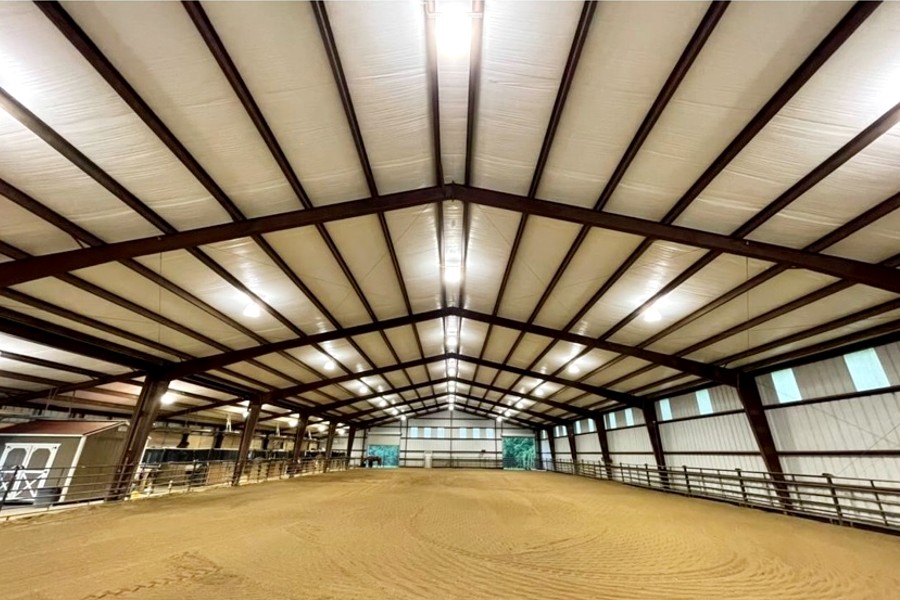
In today’s modern world, lighting plays a crucial role in enhancing productivity, safety, and energy efficiency in large indoor spaces.
LED high bay lights have emerged as a popular lighting solution due to their numerous advantages, including energy efficiency, longevity, and superior illumination. This essay aims to provide a comprehensive guide on how to install high-bay led lights in large indoor spaces while prioritizing safety, avoiding electric risks, and maximizing the benefits of modern lighting technology.
I. Understanding LED High Bay Lights:
A. Definition and Function:
LED high bay lights are powerful light fixtures specifically designed for lighting large indoor spaces with high ceilings, such as warehouses, manufacturing facilities, gyms, and hangars. These lights are typically suspended from the ceiling and provide bright, uniform illumination over a wide area. They are known for their efficiency, durability, and ability to deliver high-quality light.
B. Advantages of LED High Bay Lights:
Energy efficiency and cost savings:
LED high bay lights consume significantly less energy compared to traditional lighting technologies like fluorescent or metal halide lights. Their energy efficiency translates into lower electricity bills and reduced environmental impact.
Longevity and durability:
LED technology is known for its long lifespan, which can exceed 50,000 hours of operation. This longevity reduces maintenance and replacement costs. Additionally, LED lights are more resistant to shock, vibration, and temperature variations, ensuring reliability in challenging environments.
Superior illumination and color rendering:
LED high bay lights offer high-quality illumination with excellent color rendering properties. They produce bright, crisp light, enabling better visibility and enhanced safety in large spaces. LED lights also have instant-on capability, eliminating the warm-up time required by traditional lighting technologies.
II. Pre-Installation Preparation:
A. Assessing Lighting Needs:
Before installing ufo led lights, it’s important to determine the lighting requirements of the space. This involves evaluating the desired light intensity based on the specific activities carried out and the layout of the area. Factors such as task requirements, workplane height, and desired uniformity should be considered to ensure optimal lighting performance.
B. Electrical System Evaluation:
The existing electrical system must be assessed to ensure it can support the installation of LED high bay lights. It’s crucial to check the capacity of the electrical circuits, wiring conditions, and the availability of appropriate power supply. Seeking guidance from a qualified electrician can help determine if any upgrades or modifications are necessary.
C. Safety Measures:
Safety should always be a top priority when working with electrical installations. Familiarize yourself with safety regulations, guidelines, and local building codes. Identify potential hazards, such as exposed wiring or inadequate grounding, and take necessary precautions to prevent electrical risks. Ensure you have the proper personal protective equipment (PPE) and follow safe work practices throughout the installation process.
III. Installation Process:
A. Fixture Selection:
Choosing the right LED high bay light fixtures is crucial for optimal lighting performance. Consider factors such as wattage, lumens, beam angle, and color temperature based on the lighting needs of the space. High bay lights come in various designs, including round and linear fixtures, allowing for flexibility in installation and customization.
B. Mounting and Positioning:
Determining the ideal mounting height is essential for maximizing the efficiency of LED high bay lights. Mount the fixtures at a height that provides adequate illumination while avoiding glare and shadows. Additionally, ensure proper fixture positioning to achieve uniform light distribution across the entire space, minimizing dark spots and optimizing visual comfort.
C. Wiring and Connection:
Proper wiring and electrical connections are vital for safe and reliable operation. Adhere to electrical codes and regulations while connecting the LED high bay lights. Use appropriate wire gauges, connectors, and junction boxes. Securely fasten the connections, and consider using wire management solutions to maintain a tidy installation.
D. Testing and Adjustment:
Once the installation is complete, it’s important to test each LED high bay light to ensure proper functionality. Turn on the lights and verify that they illuminate as expected. Check for any flickering, buzzing, or abnormal behavior. If necessary, make adjustments to fixture positioning, beam angles, or wiring connections to achieve optimal lighting performance.
IV. Safety and Electric Risk Mitigation:
A. Grounding and Bonding:
Proper grounding and bonding are crucial for electrical safety. Ensure that all fixtures are grounded to prevent the risk of electric shock or equipment damage. Consult the local electrical code to understand the grounding requirements and use appropriate grounding techniques, such as grounding conductors or grounding rods, depending on the specific installation.
B. Electrical Load Management:
Balancing the electrical load is essential to avoid overloading circuits and potential electrical hazards. LED high bay lights consume significantly less power than traditional lighting options, which helps reduce the electrical load. However, it’s still important to distribute the load evenly across circuits, consider load limits, and employ surge protectors and circuit breakers to protect against power surges and prevent overcurrent situations.
C. Maintenance and Inspections:
Establishing a regular maintenance schedule is crucial for preserving the performance and longevity of LED high bay lights. Clean fixtures periodically to remove dust and debris that can affect light output. Inspect wiring, connections, and other components to identify any signs of wear or damage. Promptly address any maintenance issues to ensure continued safety and efficiency.
V. Conclusion: The installation of LED high bay lights in large indoor spaces offers a multitude of benefits, including energy efficiency, superior illumination, and enhanced safety. By following the guidelines outlined in this essay, one can ensure a successful installation process while minimizing electric risks. It is important to prioritize safety, consult with professionals when needed, and adhere to applicable regulations. Embracing the efficiency and modern technology of LED high bay lights contributes to creating a well-lit, productive, and sustainable environment in large indoor spaces.
This content is part of the HWM Partnership.
- Broadway’s Rising Stars Converge: A Day Of Inspiration At Broadway Express y Más
- Adams, Hochul And More Toast $5 Billion Housing Plan: Building Dreams Together!
- Alicia Graf Mack, Dancer, Educator, And Leader Appointed Artistic Director Of Ailey
- Update: More Illnesses Have Been linked To The McDonald’s E. Coli Outbreak
- Bronx: NYWF’s 30th Annual Dinner Honors Community Leadership And Purpose
Become a Harlem Insider!
By submitting this form, you are consenting to receive marketing emails from: . You can revoke your consent to receive emails at any time by using the SafeUnsubscribe® link, found at the bottom of every email. Emails are serviced by Constant Contact









